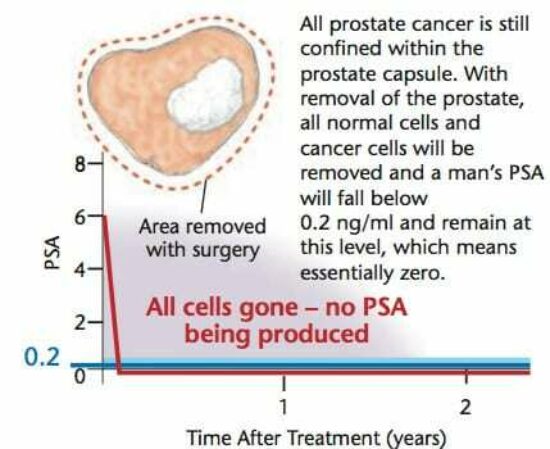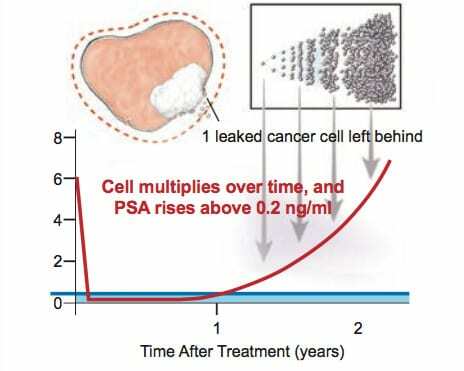Understanding the meaning of prostate cancer cure is one of the most important things in your research on this cancer. And, it’s easy to understand because it is based on the PSA test. As you know, we use the PSA test to find prostate cancer. But an equally important, maybe more important, use of the PSA test is to find out how well any treatment cures prostate cancer. Although there are questions about using the PSA test for screening for prostate cancer, there is no question about the value of the PSA test in determining cure.
With your PSA of 4.4, let’s assume you have 100 prostate cancer cells. You want to destroy all of your prostate cancer cells. If you destroy all 100 prostate cancer cells there are none to make PSA so there would be no PSA made from your cancer. Although normal prostate cells make PSA, you also want to destroy all your normal prostate cells.
Remember, your cancer was started by one of your normal prostate cells transforming into a cancer cell. Whatever caused this change in your one cell could do it again in another normal cell in the future and then you would have a second prostate cancer. Because of this, you want to destroy not only all cancer cells, but all your normal prostate cells to keep you from getting a brand new prostate cancer. If you did this, then you would have no prostate cells, normal or cancer. Since only prostate cells make PSA and you would have neither normal nor cancer prostate cells, your PSA test would show this by going to zero.
It depends on what treatment you receive for your cancer. If, for example, surgery (Radical Prostatectomy) is done, the whole prostate is cut out which means all normal cells are removed.
Like surgery, radiation should destroy all the normal and cancer cells in the prostate. This is because normal prostate cells cannot take as much radiation as cancer cells and are easier to kill. So if a radiation program destroys all cancer cells, it will also destroy all normal cells and the PSA will go to zero just as if the prostate were removed.
Correct. Women don’t have prostates and have no PSA. However, if we were to run a PSA test on your wife, the test result would not show 0.0. Depending on the quality of the PSA test, her PSA reading would at least be below 0.2 or <0.2. This means the PSA test can measure PSA down to 0.2 ng/ml, but the < means her PSA is below 0.2; below what the PSA test can measure. In other words, she does not have a measurable amount of PSA which is another way of saying zero. PSA <0.2 is called an undetectable PSA which means the same as zero PSA. So, if all your cancer is killed, which would also kill all normal prostate cells, you would have a PSA level like your wife which would be at least <0.2 or zero.
No. Achieving zero PSA after treatment is the first step in being cured, but there is a second step. Let’s again assume you have 100 cancer cells with your PSA of 4.4. Then, let’s assume you have surgery but only 99 cancer cells are cut out leaving one cell behind in your body. You could also assume you have some form of radiation which destroys 99 of the cancer cells and leaves one. That one cancer cell would make an extremely tiny amount of PSA which would be so small it could not be measured by a PSA test. Because of this you would have a zero PSA right after treatment, an immeasurable amount.
All cancer inside the prostate and no cancer cell leakage.

Just as when you first developed cancer from one cancer cell, this one cancer cell would eventually start multiplying and making more and more cancer cells. More and more cancer cells make increasing amounts of PSA and your PSA would eventually become measurable, which means above 0.2. When the PSA starts going up after going to zero it means the cancer is re-growing and is called recurrent prostate cancer.
Microscopic capsule penetration with one cancer cell left behind.

If there is significant cancer cell leakage, one or more cells may be left behind after surgery. Consequently, although the PSA will initially fall to zero in time, the one cancer cell left behind will multiply and eventually make enough PSA so that the PSA will rise above 0.2 ng/ml. This means the cancer has recurred, since all normal prostate cells would have been removed at surgery.
A measurable PSA, PSA above 0.2, after any treatment means the treatment failed to cure you and you have recurrent prostate cancer.
Quickly and efficiently build the materials you need to support your inbound marketing strategy. Drag and drop building blocks including testimonials, forms, calls-to-action, and more.